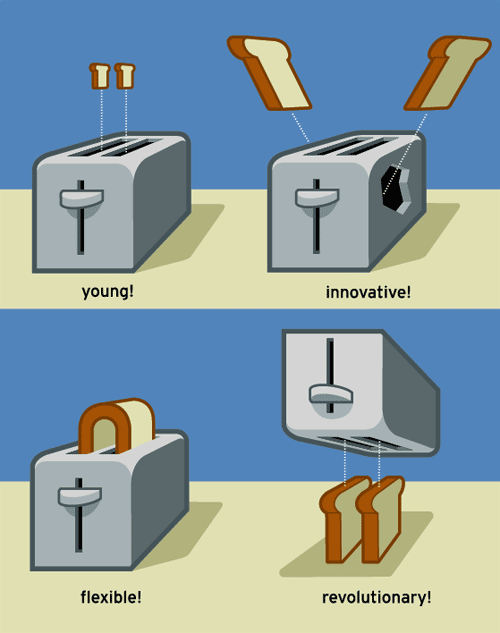Let’s start with the fun stuff. Then the dry commentary. Check out two visual cornua copiae (or, as you might have it [and as I had it until I looked it up], “cornucopias“):
1. http://christophniemann.com/ (take some time in his galleries…A LOL experience guaranteed, or your time cheerfully refunded.)
2. http://www.asofterworld.com/index.php?id=579
(That’s just one example of a softer world’s comix. More to choose from in the archive.)
 I put it to you that Christopher Niemann’s delightful and brilliant illustrations are unique to the digital age, in style, content and often in form. A Softer World meanwhile represents a new format for comics for the digital age, combining photography, illustration, and an edgy contemporary wit.
I put it to you that Christopher Niemann’s delightful and brilliant illustrations are unique to the digital age, in style, content and often in form. A Softer World meanwhile represents a new format for comics for the digital age, combining photography, illustration, and an edgy contemporary wit.
Amidst all of the debate about rethinking books, newspapers and magazines for the web here are two related media that have quietly reinvented themselves while everyone stared blankly into their repsective screens.
Wikipedia won’t define “comix” per se. The editors insist that there are three different kinds of comic(x)s:
-
Comics: i.e. “mainstream comics”
-
Underground Comix: “depict content forbidden to mainstream publications by the Comics Code Authority, including explicit drug use, sexuality and violence”
-
Alternative Comics: “a range of American comics that have appeared since the 1980s, following the underground comix movement of the late 1960s and early 1970s”
The wiki differentiates between “underground comix” and “alternative comics” (with a “c”, with a “c”!) strictly by method of distribution: “The distribution of underground comix changed through the emergence of specialty stores,” i.e. once comiX found commercial acceptance they were no longer underground. Now they were “Alternative” and had their “X” replaced with a “C”.
Can you think of another publishing example where the product had to be reclassified when only the distribution method changed (while the content remained the same)?
A banner headline above the alternative comics’ article notes: “This article does not cite any references or sources.” Well I guess we can rely on it then. (Please see the New York Times: “a student reprimanded for copying from Wikipedia in a paper on the Great Depression said he thought its entries — unsigned and collectively written — did not need to be credited since they counted, essentially, as common knowledge”.)
By coincidence I heard today that Digital Book World will be offering a free webinar next Tuesday that’s right on topic: Digital Strategies, Learning from Comics Publishers. More info and registration link here.
















